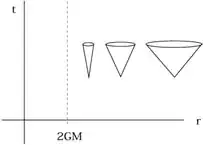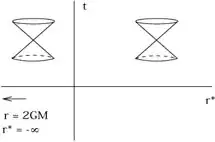I do still not really understand the solution for a radially falling body in the Schwarzschild metric:
One the one hand, in terms of proper time $\tau$ the equation of motion can be solved and gives a solution $r(\tau)$ for $r\ge 0$. The body crosses Schwarzschild radius $r_s$ without any problems and the solution is valid also for $r\le r_s$.
On the other hand, the same calculation, carried out in coordinate time t shows, that the particle is never reaching $r_s$ in finite time.
The body definitely crosses the Schwarzschild boundary (although is cannot be proven, because nobody can come back), but why is there no solution for $r\le r_s$? What is the deeper reason, that this region is not mapped by using t? I would expect, that a switch to a new coordinate system maps a point into another unique point. For points inside $r_s$ this seems to be not possible anymore, but, on the other hand, I can easily mark an inside point in the t-r-Diagram and the Schwarzschild Metric is, from its definition, not restricted to $r>r_s$.
I know, that its an artifact due to geometry, but how can it be, that the mapping of inside points between the two coordinate systems fails? Naively speaking, there should be a solution also for the region within Schwarzschild radius because moving astronauts COULD get there and make a meeting. This Meeting, taken as a real event is not visible in the t-r- coordinates. Thinking about that makes me crazy...

